The importance of search engine optimization (SEO) in 2021 is stronger than ever as Google rolls out new UX-focused Core Web Vitals. Now that user experience clearly plays a vital role in search rankings, smart marketers are rethinking what it means to have a solid SEO strategy that drives web traffic and lead generation.
With a constantly evolving ecosystem of different platforms affecting search, as well as the continuous updates to the algorithms of each search engine, it’s more difficult than ever to maintain a competitive advantage with SEO.
The first step to understanding your company’s progress with SEO is performing an SEO audit to systematically identify its strengths, weaknesses and areas of improvement for the future.
Are you and your team set up with a proven process for auditing your SEO strategy?
Got ya covered.
This comprehensive guide outlines 15 steps Digital Current performs SEO audits. We’re peeling back the curtain on the critical steps for benchmarking your site, troubleshooting issues, and growing traffic with SEO.
Steps to Auditing Your Website’s SEO
- Crawl your site
- Identify your goals
- Install Google Analytics and Google Search Console
- Run a speed test
- Check your XML sitemap
- Run a mobile-friendly test
- Analyze your security
- Take inventory of your content
- Gather customer insights
- Check for duplicate content
- Determine your website’s indexability
- Define a keyword strategy
- Audit your backlink profile
- Analyze local citations
- Review social media
Start Crawling
Before starting the five-pillar process for an SEO audit, it is essential to first crawl your website to begin gathering data to analyze and better understand the site’s progress.
Crawling is the process of using a tool to review the pages that make up a particular website to map the site, understand the topics it is covering, identify any issues and more.
Third-party crawling software provides a detailed report of a site’s content to provide insight into how the search engines might view the same site.
No third-party crawler is going to be 100% accurate compared to a search engine’s bots, but these tools provide a strong enough approximation of a site’s progress.
Screaming Frog has a free version that provides good insight into the progress of your website.
Screaming Frog helps website owners:
- Find broken links
- Discover duplicate content
- Generate an XML sitemap
- Detect temporary and permanent redirects
- Collect data from the HTML on a web page
- Review URLs blocked by robots.txt
- Analyze the title tags and meta descriptions on your pages
- Integrate with Google Analytics to pair landing pages against a crawl
Up to 500 URLs can be crawled on the free version of the software, but if your website is larger, consider buying the pro-version of Screaming Frog for around $165 a year.
To begin, download the program, enter the URL of your website’s home page in the empty field that says Enter URL to Spider then press Start.
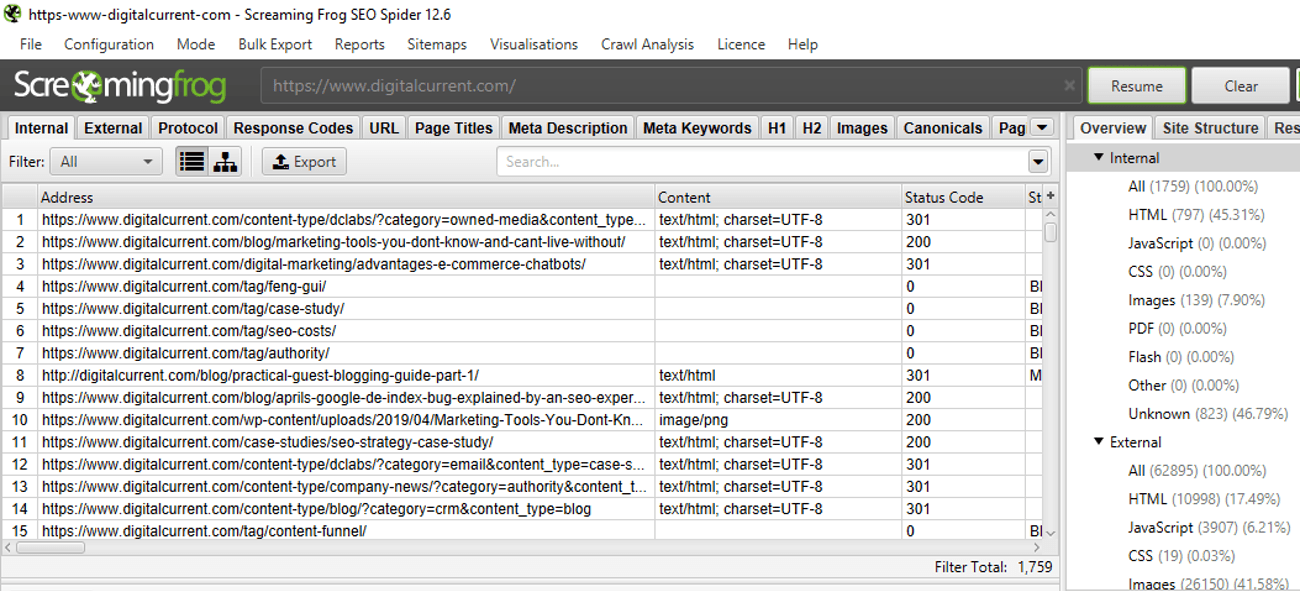
Export the full report to Excel for the ability to customize it later as you complete this audit.
Leave the generated report on the website open within the software as we will be revisiting it later in the audit.
Pillar 1: Conversion
The main goal of your SEO campaigns should be to generate conversions. A conversion is the act of driving action from a person visiting a website, whether that’s increasing sales of your products, encouraging downloads of a resource or another action.
Focusing on conversions matters because visitors must be convinced to engage when they’re active on your website. Otherwise, they aren’t qualified, and your marketing budget is being spent to attract people that don’t buy or do anything of worth.
If the traffic sent to your website from Google isn’t converting, it can hurt your bottom line. According to the CXL Institute, businesses that have a system in place for conversion optimization are twice as likely to see large increases in sales.
A lack of engagement from visitors may lower your rankings, as Google views people immediately returning to search after first visiting your website as a sign that the site isn’t relevant.
To understand if your website is equipped to drive conversions from SEO, take the following steps:
- Identify the objectives of this SEO audit as they align with company goals.
- Analyze the accessibility of the website to drive conversions.
Identify the Goals of the SEO Audit
It’s essential to understand what goals you’re focused on in order to prioritize where you’re spending time, as well as to understand what types of conversions are important to monitor on behalf of your business.
No two companies are focused on the same exact objectives, which is why it is important to customize your approach to SEO accordingly.
Don’t settle for choosing just one goal or one conversion type, as your company will be missing out on the full range of benefits an audit and SEO overall can provide. At the same time, don’t focus on too many goals and conversion types at once because it may overwhelm your efforts with too many data points to reference.
The goals of your SEO audit could be to:
- Identify existing SEO issues
- Understand progress compared to competitors
- Fix a particular aspect of your SEO strategy
- Inform your team of potential areas of growth
- Rank for a certain list of keywords
Examples of the specific types of conversions worth monitoring are:
- Downloading content like a PDF, whitepaper, etc.
- Making a purchase
- Filling out a contact form
- Subscribing to an email list
- Watching a video
- Adding to a cart or wish list
- Job application submissions
With an understanding of what your business is trying to achieve with an SEO audit, it’s time to clarify how accessible your website is to both visitors and the search engines. It is also important to measure the conversions happening on a website to understand if your SEO strategy is successful.
Analyze the Accessibility of the Website
Set up Google Analytics and Google Search Console
Google Analytics is a free web analytics platform provided by Google that allows businesses to measure what is happening on a website, in addition to tracking conversions from search and elsewhere.
Google Search Console, formerly known as Google Webmaster Tools, is another free tool to help businesses monitor their presence in the search results and detect any errors in the indexing of a website.
Installing either tool is not considered a formal factor for whether a website is indexable or not, but installing Google Analytics and Search Console code on a web property is certainly an indication to Google that a website exists.
To check if Google Analytics is installed, follow these instructions outlined by Google to access your account and see if it’s collecting data or not. Another way to detect if Google Analytics is installed on a website is to enter the URL at GA Checker.
To detect if Google Search Console is set up for your business, log in to the tool with your Google account to see if the website has been added or not.
If Google Analytics needs to be installed, then add it following their instructions and if Google Search Console needs to be added, follow the directions here.
While reviewing an existing account or setting up your Google Analytics for the first time, evaluate if goals for conversion tracking are set up properly, as well.
Goals in Google Analytics allow a business to track if the conversions you’re focused on are happening or not, whether that’s the download of a resource or a sale of a product.
Learn how to set up goals in Google Analytics by following this tutorial from Google.
Determine Site Speed and Page Caching
The time it takes a website to load is essential — 47 percent of consumers expect a web page to load in two seconds — especially since Google considers page speed as a ranking factor. Google even recommends that above-the-fold content load in under a second to provide the best experience to searchers.
To understand how quickly your website is loading, use the Pingdom Website Speed Test tool, as it’s free and makes it easy to understand results at a glance. Aim for a performance grade of a C or better to ensure your website is performing effectively.
Not only should you analyze the speed of your website’s homepage, but also the top 10 best-performing pages in regards to whether they are heavily trafficked, drive the most conversions or otherwise.
To get a sense of how other websites perform, simply enter the URL of a top news site or another website you’re familiar with to see how fast these sites are in comparison.
Review the site speed of the five top competitors in your industry to understand who’s loading faster or slower. Reviewing the site speed of competitors will help establish priorities in terms of how much optimization is needed on your own site.
If you’ve received a low performance grade, consider optimizing your site for speed to reduce the time it takes for your pages to load and increase the likelihood a visitor will convert.
Another way to increase the load time of your site is to ensure the caching of your web pages is enabled. Caching a page in your browser is the automatic process of saving a page for a visitor so it doesn’t have to be loaded entirely the next time they visit.
This decreases the time it takes to load a page and provides a person with a better experience with your website overall. Review the performance insights at the bottom of the Pingdom Website Speed Test tool to receive a grade for each element that impacts the speed of your website load time.
For elements with a grade of ‘C’ or lower, review the tool’s recommendations for improving the caching performance, like further combining external JavaScript and CSS.
Is There an XML Sitemap?
An XML sitemap is a list of pages on a website that are available for crawling on the search engines, providing search bots with information on what to index.
The first step of this process is to determine if your website has a sitemap currently or not.
Add /sitemap.xml or /sitemap_index.xml to the end of the URL of any website to see if a sitemap is present or if a 404 page loads instead, which means there isn’t one on the website. Another way to check is by using the Sitemap Test tool for a diagnostic.
If a website has an updated XML sitemap, then no further action is needed. If no XML sitemap is found on the site, pull up the Screaming Frog SEO Spider report within the software as seen above and select Sitemaps and then Create XML Sitemap. For more details about creating an XML sitemap, review this resource from Screaming Frog.
Once created, add the XML sitemap to the website’s Google Search Console account to confirm Google has access to the file. Google will crawl a sitemap on its own, but this is an added precaution to ensure the structure of the website is clear.
Is There Cross-Device Compatibility?
Over half of all Google searches worldwide happen on mobile, requiring every website to be optimized for mobile users and the search engines across devices.
To test whether your website is compatible for mobile, use Google’s Mobile Friendly Test tool, Bing’s Mobile Friendliness Test Tool or Varvy’s Mobile SEO tool. Each tool will clearly indicate whether a website is mobile-friendly or not, as well as make some recommendations on how to correct any existing errors.
One common issue encountered when making a website mobile-responsive is not having a viewport meta tag in the <head> of the website, which is needed to adapt a page to different screen sizes.
Having a mobile-friendly website is also an SEO factor, among the many, that Google uses to understand how highly to rank your website or not in the mobile search results.
Beyond compatibility, driving conversions from search on mobile requires your website be catered to how consumers actually use these devices to research and shop.
“What most businesses don’t realize is that a mobile user is at a different stage of the buying process and is trying to accomplish a different task than they would on desktop,” said Bryan Eisenberg, a partner at BuyerLegends.com, keynote speaker and best-selling author.
According to Eisenberg, when people are sitting at their desktop, it’s like they are sitting down with you for a whole meal. They are ready to do research with the help of search, fill out forms, etc., as they are more involved in the task.
When people grab a mobile device, it’s like they are snacking. They are on the go, grabbing a couple minutes between a break, making a quick search, on the toilet, etc.
Adapting your strategy to account for these considerations is important, as your SEO won’t drive the results you’re looking for if the mobile experience doesn’t match a consumer’s expectations.
The significant challenge businesses face driving conversions is understanding the unique behaviors of mobile users. More specifically, how to guarantee users have a great experience accomplishing a task on the site, and connecting mobile activity with desktop.
“It’s all about using mobile devices to drive the desired user behavior, whether that’s closing a sale online or encouraging a customer to experience their products in-store,” added Eisenberg.
Is Your Site Secure?
With close to 1 billion sites created to date, it is important to consumers that they are visiting secure and reputable websites. Google also values security, taking HTTPS/SSL encryption on a website as a ranking signal.
The goal of adding this level of security is to prevent spammers and malware attackers from impersonating a website, taking user data or monitoring their habits as they visit. It can also help decrease the likelihood a visitor will bounce when viewing your website, providing more opportunity for them to convert.
To analyze the security level of your website, use Site Analyzer and run a page analysis to view the security report detailing if HTTPS is enabled and has a valid certificate, in addition to other security factors.
Pillar 2: Content
Content is copy on a landing page, a blog post, a services page, an infographic, video, an interactive quiz or any other information that lives on your website or a third-party platform (like social media) that provides value to your audience.
72 percent of marketers surveyed said relevant content creation was a major key to success. The content included throughout a website is important because it provides the search engines with an indication of what topics the site is an authority on, and it gives visitors the opportunity to find the answer to the questions they are searching for.
The act of creating content is an equalizer for all websites. No matter the size of your budget or level of prestige, every business can improve rankings and convert their customers with quality content.
However, it’s more challenging to compete for attention in search, as many organizations are investing in content, which is why it is necessary to thoughtfully produce content and develop a multi-channel content strategy to account for non-SEO related goals.
Keep in mind that success with content and SEO doesn’t occur within a silo, but with a varied approach to multiple marketing mediums and strategies.
Not every SEO tactic is going to work for every organization. That is an important consideration to keep in mind as you complete an audit.
When using content to achieve results from SEO, success comes down to the topics chosen, format choice, content quality, how content is promoted and how it is optimized.
To understand if your website is leading with content for SEO, take the following steps take an inventory of your existing on-site content.
Content Inventory: An inventory is a starting point for understanding all the content a business currently has live on its website to date. Conducting an inventory identifies high-performing content and any problem areas with content, as well as which gaps in coverage are worth addressing.
Content Review: Looking at the earlier reports from Screaming Frog provides a list of all the active URLs on a website. Reference these to quickly identify every page on your site and start sorting out irrelevant pages.
To organize the Screaming Frog report around existing content, filter out irrelevant pages that aren’t active or are redirected.

Look above at how column C highlights the status of each individual page on a website whether they are active (200), permanently redirected (301), temporarily redirected (302), blocked by robots.txt (0), or broken/inactive (404).

Highlight column C on the report and select the sorting button in descending order to organize the entire document by status code. It’s much easier to review existing content when it is grouped together and easier to remove or ignore broken and redirected pages for this part of the audit and instead focus on any 200 coded page.
Next, download an additional report from Google Analytics to combine with the Screaming Frog report to add your organic search traffic to the content inventory.
Access the Acquisition report in Google Analytics, then All Traffic, then Channels and then finally select Organic Search.
There are a few systems of measure that determine if a website is simple to read or not, including the Gunning Fog Index that measures readability from a 1 to unlimited score. The ideal score for most organizations is from 7 to 8.
Another system is the Flesch Kincaid Grade Level, which measures readability based on academic grade level from 0 to 12. The average score is an 8, which is having content be at an 8th grade reading level, which encompasses most adults in the U.S.
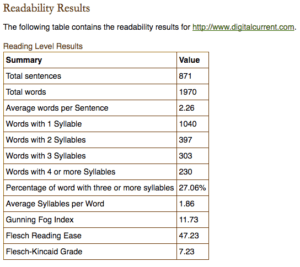
To measure how easy it is to read the content on your website, try the Juicy Studio readability tool (as seen above), the Readability Test Tool, or the Dairy Science text readability score.
Content Quality: Google demands that content on a website is high-quality in order to serve searchers the best answers to their questions, which in the end, helps the search engine make money, as more people continue to trust and use their service.
Visitors look for reputable sources of information they can trust to answer their questions, which over time builds a relationship with them and your business. This ideally drives these users to make a purchase, contact your organization, etc.
Determining the quality of content on a website is subjective at times, but is better made clear by first understanding what content your customers want, and secondly, by comparing the content of competitors to your own.
To understand what content your customers are looking for:
- Review the searches conducted on your site’s search box to see what people are looking for and if there are any gaps you’re not addressing. Here’s how to quickly configure the site search report in Google Analytics.
- Conduct user testing on your website and specifically ask respondents to review, read and interact with your content to get their feedback. Usertesting.com is an affordable tool for getting real people to examine your website and send back a report regarding their findings.
- Create surveys to send to your audience through SurveyMonkey, Google Forms or Typeform. Ask questions related to how customers view your existing content and if they found it to be a useful resource or not.
Reviewing the content of competitors can also help clarify the areas of content your organization excels at and also what ways your content needs to improve.
Using a tool like Ahrefs Content Explorer or BuzzSumo, analyze the best-performing content by topic, competitor or industry by conducting a search and reviewing what’s in that category.
Both tools offer insight into what organic traffic and social sharing each piece of content drove for a given search. Competitive data from these tools can inform what content pieces to review and compare to your own for inspiration for future content or confirmation you’re on the right path.
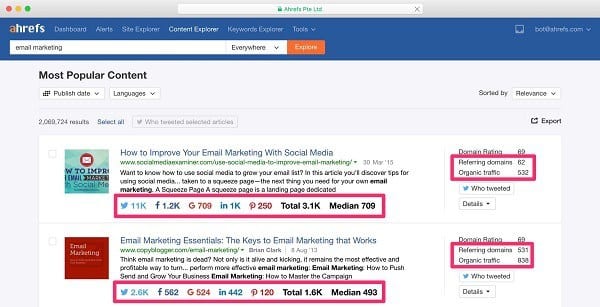
Content Length: Another indicator of quality content, in particular with Google and the search engines, is the length of the written content included throughout a website.
Neither long nor short content is better than the other, as it depends on how it’s being used; some circumstances call for one or the other.
If an article is 200 words or 2,000 words and doesn’t really contain useful info, Google will regard this as a piece of low-quality content. This is labeled as such because it is an attempt to rank for a particular keyword with little to no effort, mainly because low-quality content provides no value to a reader.
The length of an article or product page is important to a visitor as well, but it’s situational as it depends on how in-depth a person is willing to go to read up on a particular subject. An article of 800 words on a subject may be useful to one person, whereas a video with a 300-word summary might be more valuable to another.
There is no exact word count to aim for in all situations, for all websites. Instead, focus on making all content for your website useful, well-researched and relevant.
As a general rule of thumb, articles, blog posts and other written resources (not necessarily your product and services pages) shouldn’t be less than 500 words. Any less and there is often not enough room to fully explain a concept. However, there are always exceptions. This is just a recommendation to remind website owners to put thought into their content.
Multiple studies have found that there is a strong correlation between lengthier content of 2,000+ words and its ability to generate more social sharing and backlinks.
This doesn’t mean longer content is guaranteed to perform well, as it still needs to provide utility, quickly answer a question for readers and offer more value than other sources on the subject.

To understand the length of content on your website, refer to the content inventory created from your Screaming Frog report and view the Y column for the word count of every page when it was last crawled.
The first priority is to understand why any pages have a word count of 0 and then identify which pages have a low word count to understand if it’s appropriate for that particular page or not.
Duplicate Content: Google penalizes a site when multiple versions of the same content exists on your website or across multiple websites by accident or with the purpose of deceiving the search engines.
In many cases, duplicate content occurs unintentionally, like when a page has a printer-friendly version or a product page has multiple versions to illustrate a different style of the same product.
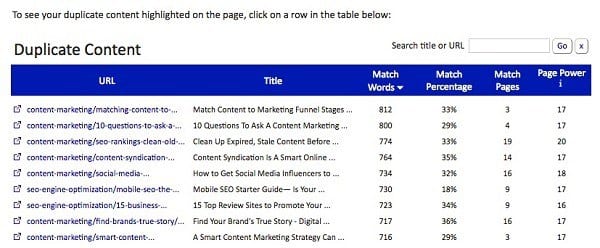
To detect duplicate content on your website, use a tool like Siteliner or Google Search Console, under the Search Appearance report, then visit HTML Improvements to see any duplicate content issues listed.
If your website does contain duplicate content, take one of the following suggestions from Google to correct the issue.
Pillar 3: Optimization
The optimization of a website is the process of continually evaluating and improving its many elements to ensure it’s prime for indexing and ranking in the search engines for the right keywords. Optimization is also when you ensure the website provides the best user experience.
It used to be enough to have rankings and links, but now Google values when visitors consume content on your site, interact with your offerings and share it with others.
When reviewing your progress with SEO, use this section to understand both what’s happening on a detailed level, but also how each part of the process complements the overall experience of visitors.
On-Page Ranking Factors
On-page ranking factors consist of the HTML elements found on every page of a website that can be optimized to help it accurately rank in the search engines. Like any factor that Google considers about a website, on-page optimizations are one step of the overall process and cannot be manipulated.
Title Tags: The HTML title of any page on a website is referred to as the title tag. The goal of the title tag is to identify the topic of a particular page to help Google understand its focus, as well as display the name of the page in the search listings for searchers.
The title tag should be defined by the website owner to accurately describe what the page is about and give Google a clear indication of its purpose on a website.

To review all the title tags used on a website, refer to column E on the Screaming Frog report that is labeled Title 1. To the right of that column, review Title 1 Length, which is column F, to understand how many characters each title tag is comprised of on every page.
Not only do title tags need to accurately describe the page they are referencing, including keywords naturally, but they also need to be fewer than 55 characters in order to not get truncated in the search results.
Also check to see if any title tags are duplicated and correct them to ensure each is original and relevant. Title tags are typically easy to edit in the back-end of WordPress or another content management system (CMS).
Meta Descriptions: The meta description is HTML used on each page of a website to provide a brief explanation of what subject is covered. The meta description is about two sentences long and is located below the title tag in the search listings.

Meta descriptions are not considered a factor by Google when it comes to page rankings. Instead, meta descriptions are used by searchers to decide whether to click on a search result or not, which improves click-through rates and impacts how Google views a particular webpage.
To review all the meta descriptions on a website, check column H on the Screaming Frog report and also view column J to review the character count for each.
Meta descriptions should be no longer than 156 characters to prevent it from being truncated in the search results. This HTML tag can also be edited in WordPress or with another CMS.
URL Structure: The URL of every page on a website is also considered a ranking factor (albeit low), as it is meant to help identify the overarching subject of the page to both visitors and the search engines.
From an SEO and user experience perspective, all the URLs on a website should be specific and concise to keep the navigation of a site organized. Aim for no more than five or six words in the URL, separated with dashes and without any common words.
For example, makeup retailer Sephora uses the following URL for their product category of fragrances: https://www.sephora.com/shop/fragrance
Another example is from the tech publication Mashable using the following URL for an article titled “3 Easy Ways to Make a Lackluster Resume Shine”: http://mashable.com/2016/07/28/improve-weak-resume/
To review all the URLs included on a website, refer to the Screaming Frog report and look at the first column to see where each page stands.
Headers: The pages of your website should be organized with headers and subheaders to make it easier for readers to review a page or article. Including header HTML tags (<h1>, <h2>, <h3>, etc.) for these various headers also helps the search engines determine the focus of a page for ranking purposes.
The main header of a page should be designated with an <h1> header tag, sub-headers with <h2> header tags, <h3> tags for sub-headings of the sub-headers and so on.
Don’t over-complicate the page with too many tags or overly categorized information, as the focus is to create a worthwhile resource that is valuable to your customers. Review the <h1> and <h2> tags on your website in column M through T of the Screaming Frog report.
Alt Image Tags and Image Filenames: Including visuals throughout your content improves the experience for people visiting a website, making it more engaging for many consumers who are primarily visual learners.
The search engines review the alt tag and the filename associated with an image used on a website to determine its subject for ranking purposes. This HTML tag and the filename should be an accurate and concise description (100 to 200 characters approximately) of what’s actually shown in the photo, drawing, infographic, etc.
To ensure all images on a website include a concise alt image tag, select Bulk Export using Screaming Frog after your website has been crawled and choose Images, then Images Missing Alt Tags to create an Excel document listing every image missing this important HTML tag.
Technical Optimization
Optimizing for SEO from a technical perspective not only positions a website for success in search but also adds value for other areas of your marketing, like content strategy, social media, pay-per-click advertising, and more.
To understand if your website is optimized for SEO correctly:
- Determine the website’s indexability.
- Focus on a specific keyword strategy.
Determine the Website’s Indexability
Before conversions from organic search are possible, understand if the search engines are correctly adding your webpages to their indexes for ranking.
Robots.txt: The robots.txt file is used to tell Google to ignore a page that shouldn’t be included in the search results, but not all companies need to use this file as many don’t need to block any content from search.
It’s perfectly normal to block certain pages while developing a website or if you’ve got premium content your company doesn’t want indexed, among other reasons.
To determine if any important areas of a website are blocked, add /robots.txt to the URL of any site like this: http://www.example.com/robots.txt
If you have a file on your website, you’ll see HTML. Here’s what the text means:
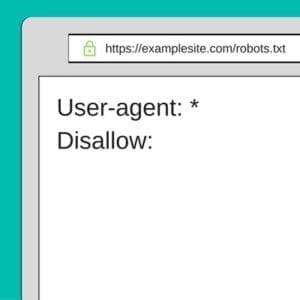
The entire website is discoverable for the search bots, which is ideal.
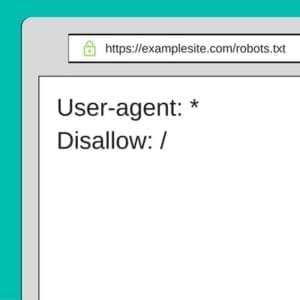
The entire website is blocked from the search bots, which is not ideal.
The main problem to look out for is if all of your content is being blocked from the search engines. It is fine if only certain pages are blocked as long as there is a reason.
If particular pages are being blocked, here is what the text will look like on the file:
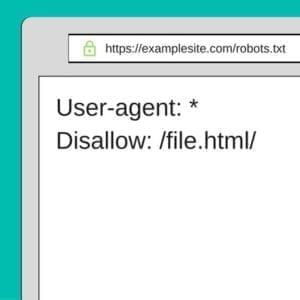
A particular file is blocked from the search engines.

A particular folder is blocked from the search engines.
Robots Meta Tags: Functioning similarly to the robots.txt file, Robots Meta Tag is special HTML included in the <head> of a website used to inform the search engines to not crawl or not follow the links on a particular page.
If a page is blocked from being indexed or from following the included links, the HTML would look like this:
No Index Page & No Follow Links:
<html>
<head>
<title>…</title>
<META NAME=”ROBOTS” CONTENT=”NOINDEX, NOFOLLOW”>
</head>
No Index Page:
<html>
<head>
<title>…</title>
<META NAME=”ROBOTS” CONTENT=”NOINDEX”>
</head>
No Follow Links:
<html>
<head>
<title>…</title>
<META NAME=”ROBOTS” CONTENT=”NOFOLLOW”>
</head>
For more Robots Meta Tag options, refer to Bing’s how-to on the subject. To detect whether there are Robots Meta Tags on your website, refer to Google Search Console to see if any pages are blocked, and then visit those pages to review the HTML used.
Flash and JavaScript Navigation: The navigation structure of your website shouldn’t be built entirely in Flash and JavaScript, as this outdated technology makes your site difficult to interpret by the search crawlers.
To identify the use of Flash in your navigation, refer to the SEO SiteCheckup Flash Test for a quick overview by entering the URL of your website.

If Flash is detected, it’s time to redesign those elements, as the technology is defunct and difficult to be crawled or viewed on mobile. Replace Flash and JavaScript navigation with schemes based on CSS and XHTML.
Identifying Manual and Algorithmic Penalties: Penalties from Google can remove a website’s rankings and reduce traffic significantly, either due to an issue on a specific website (manual) or a change made to the Google algorithm that affects a problem present on many sites (algorithmic).
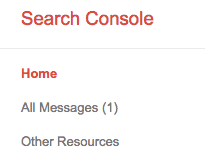
To identify any manual penalties against a website, visit Google Search Console and review messages sent to the specific website by Google regarding any issues.
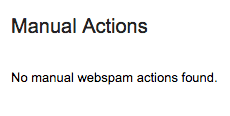
Secondly, visit Search Traffic on the menu and then review Manual Actions to see if there are any penalties. The page will look like what’s above if the website is penalty-free. If manual penalties are detected, each will be listed with a description, as seen below. Read our guide on how to fix manual actions.

To detect an algorithmic penalty on a website, pay attention to any sudden or unexplained drops in traffic in Google Analytics that coincide with news of the algorithm changing. Knowing which algorithm is affecting a website will inform what actions need to be taken to correct the issue.

Consider using the Panguin tool, as well, to align your analytics reporting with the Google algorithm history to quickly understand which penalty might have hit your website.
Begin addressing any penalties identified on your site by fixing the individual problem outlined either by Google Search Console or associated with a particular update to the algorithm.
The methods for fixing each type of penalty vary significantly, but there is a lot of documentation available on how to address each type, like dealing with duplicate content or disavowing unnatural links.
Canonicalization Issues: All the pages on a website should have a single URL for the search engines to consider. Otherwise, the authority of a site is dispersed unevenly across duplicates of the web address.
Canonicalization is a fancy way of saying there are duplicate web addresses for the same page. To build a stronger link profile and maintain competitive rankings, it is important to regularly review the web addresses across a site to ensure there are no canonicalization errors.
For example, if the web address for the Digital Current homepage had a canonicalization issue, it may appear in multiple versions, like so:
Version 1: www.digitalcurrent.com
Version 2: digitalcurrent.com
Version 3: digitalcurrent.com/
Version 4: digitalcurrent.com/index.html
Version 5: www.digitalcurrent.com/index.html
If this were the case, the different versions of the same page would lead Google to unevenly distribute value to each option as opposed to simply giving full authority to the correct version.
Use Screaming Frog to detect canonicalization issues by selecting Reports after crawling a website and then selecting Canonical Errors to create an Excel document listing any errors to address.
Define a Keyword Strategy
Reviewing the keywords used across a website is necessary to understand if the right people are searching, visiting and engaging with your offerings online. Knowing which keywords your company wants to rank for versus which keywords you’re actually ranking for can help inform how your entire website should be optimized.
Keyword Frequency: To continue to rank highly for a variety of relevant keywords related to your organization, the first step is to analyze what you’re ranking for and how frequently you’re using keywords related to specific subject and product categories.
To understand which keywords a website is currently ranking for, use a tool like SEMrush, KeywordSpy or Moz’s Keyword Explorer. Each tool will generate a list of keywords your domain is ranking for, the position each keyword holds in the search engine results pages and the estimated search volume for each search term.
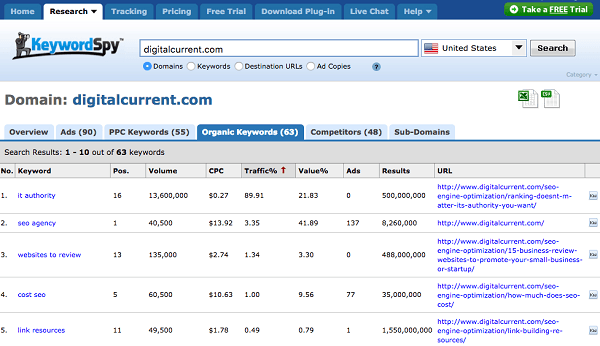
Export a list of keywords from one of these tools into an Excel document and start organizing them into different categories of your choosing, based on the topics areas or products they are addressing.
Once your keywords are organized into categories, it’ll be simple to see which groups are consistently ranking more highly than other groupings in search. By understanding the frequency at which your keywords rank, your organization will be able to:
- Identify which types of keywords to continue to optimize for
- Develop ideas for related keywords to invest in
- Understand which keywords and keyword groups are underperforming
- Clarify which keywords are too competitive and should no longer be optimized for
Remember that rankings aren’t the most important SEO metric, since a high position doesn’t guarantee qualified traffic, but it does give an indication of how your content is performing in search compared to competitors.
Competitive Analysis: The keywords your competitors are ranking for not only inform your SEO strategy, but also your pay-per-click advertising campaigns. Use one of the keyword analysis tools above to review the websites of your leading competitors to understand what they rank for and what your organization should consider focusing on, as well.
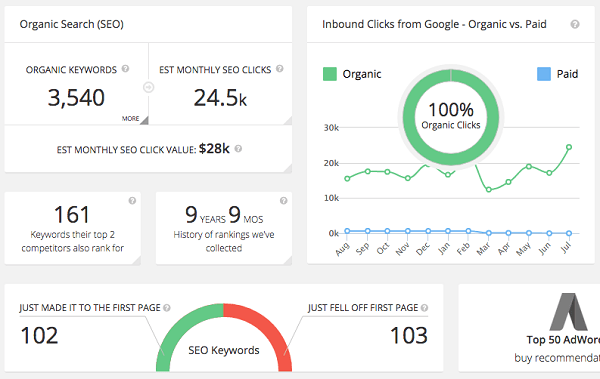
SpyFu is another useful tool for competitive keyword analysis that provides a quick review of how many keywords a competitor is ranking for on the first page, as well as a list of all their organic keywords.
Compare and contrast the keywords your company is ranking for versus competitors to see which gaps aren’t being addressed and are worth investing in further.
Pillar 4: Authority
An organization can create and optimize the highest-quality content in their industry, but if no other websites link to it, then it won’t generate the authority Google deems necessary to rank as a resource in search.
“Link authority and brand signals are considered the most important ranking factor because they have proven time and time again to be effective at producing quality search results for Google,” says Jarrod Hunt, partner at Digital Current.
Authority is defined by the search engines as the quality backlinks and social shares your website receives from others that truly confirm your expertise in an industry.
“Over the years, Google has tested removing or reducing the weight they give links in their algorithm only to find that the resulting search results were not as relevant or useful,” adds Hunt.
“It is very unlikely that Google will reduce the importance of link signals anytime in the near future. On the contrary, as they continue to refine their ability to root out link spam, links that are naturally given and coming from top-tier content providers will likely have even more of an impact on your rankings.”
Understanding how to both attract attention from third-party websites organically and build relationships with other authoritative organizations in your niche will help improve your SEO in the long-term.
To understand if your website is generating the authority it deserves:
- Analyze and interpret your website’s link profile.
- If applicable to your business, focus on local citations and reviews.
Conduct a Link Audit
Run a report on an existing website to see what links have been generated to date, what spammy links need to be disavowed and where competitors are with their own link profile.
Review Link Profile: Refer to Google Search Console to first get a quick overview of the total number of links to your website according to Google, what websites link to the site the most, your most linked-to content and the most common anchor text used to link to your site.

Next, use a third-party tool like Open Site Explorer or Ahrefs SEO Backlink Checker to do a full backlink report on your website. Running a report with Ahrefs provides an extensive review of the:
- Number of backlinks
- Number of referring domains
- Types of referring domains (.gov vs. .edu vs. .com, etc.)
- Sources of a site’s backlinks
- Dofollow vs Nofollow links
- Timeline of links generated
- Most common anchor text included
- Most linked-to pages
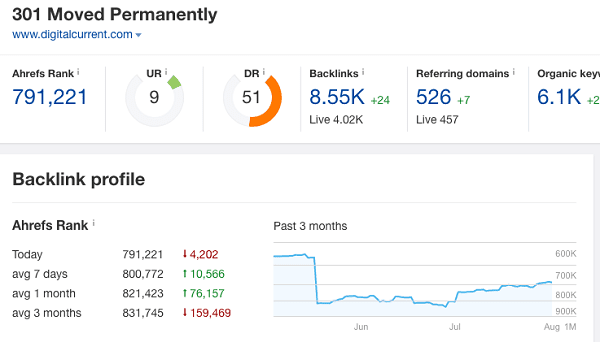
Export the Anchors report to view all the anchor text used with every backlink or the Top Referring Content report to view every piece of content referring links.
Disavow Low-Quality Links: While reviewing your backlink profile on a link-by-link basis, identify any links that don’t add value and potentially reduce the authority of your website.
Hunt says that if you’re not proactively disavowing low-quality links, there is a good chance that your backlink profile has its issues.
“If you are a big brand with tons of quality links, this might not be a huge issue, but it’s worth watching, or if you are a smaller brand in an industry with a lot of SEO competition,” he adds. “You definitely need to review your link profile as it is easier than ever for your competitors to build low-quality links to hurt your rankings and trust.”
While reviewing the Ahrefs link report, look for links from low-quality, spammy sites with no unique content, too many ads across a website or sites that try to game the search engines with tactics like keyword-stuffing. If there’s a high volume of low-quality links or unnatural anchor text on a site that links to you, that’s another indication of the presence of harmful links.
Once a list of low-quality links has been identified (if there were any), use Google’s Disavow tool to alert the search engine which links to your website should be ignored from the index.
It is important that you’re confident the links being disavowed are currently or may in the future harm your site’s performance in Google. Links are difficult to generate, which would make it unfortunate to disavow a useful link by accident.
Fix Broken Pages (404 Errors): Broken pages across a website indicate to Google that the site isn’t well-maintained and isn’t as valuable as it could be to visitors. Fix the broken pages on your website (404 errors) on a bi-monthly or monthly basis.
After doing a crawl of your website with Screaming Frog, sort the report in the dashboard by response codes or the Excel file by the status code, bringing the 404 pages to the top of the list.
Competitive Link Review: Use a tool like Ahrefs to conduct a similar backlink review of your top five competitors. The goal of a competitive link analysis is to:
- Understand the number and types of backlinks competitors have and use this data as a relative benchmark.
- Identify the authoritative websites that link to competitors to inform your team of neglected link opportunities.
- List the most linked-to content of competitors to compare content strategy success.
Analyze Local Citations
When addressing the SEO authority of a website, it is important to review a company’s local profile in the areas where it is most active.
Local Citations: A citation is a listing of your organization’s physical location that the search engines refer to when visitors conduct a local search.

To scale your local authority, it is important that your company has an accurate local profile on websites like Yelp, Yellow Pages, Google, Bing and elsewhere.

Use a free local listings scan like Yext or Moz Local to conduct an overview of your listings for each company location. This scan pulls together a broad report to highlight where your business locations aren’t listed, as well as the types of information you’re missing, like address, phone number, etc.
If you pay to use either Yext or Moz Local, they can both help to scale and streamline the process of keeping your local citations updated across each service. However, each of these profiles can be updated manually for free for each location, as well.
The decision to pay for the tools or go the manual route depends on how many physical locations your company needs to optimize.
If there are only a few, then it makes sense to update them manually. But if you’ve got 10+ locations, it may be cost-effective to purchase a tool that automates the process to save time and resources.
Local Reviews: Reviews of your physical location influence search rankings and also impact the decision-making process of consumers looking for a business that suits their needs, whether they are looking for a restaurant or a tailor.
To evaluate your existing reviews manually, visit each local listing website where customers are leaving feedback. If your business is only comprised of one or a few locations, then looking at your existing reviews shouldn’t be too difficult of a process.

Keep track of locations that perform better than others in terms of receiving more positive reviews to learn what is done at that location and apply these lessons across your stores to increase reviews.
Take note of patterns in feedback, both positive and negative, to apply these findings, as well as respond to all negative reviews to resolve any open issues.
If your organization has many physical locations, manually checking each website isn’t an efficient use of your time, as there are tools to bring all reviews from different services into one dashboard.
Tools like ReviewPush, Reputology and ReviewTrackers allow organizations of all sizes to scale their efforts analyzing and responding to reviews, saving time and resources as your company continues to focus on building authority with SEO.
Pillar 5: Promotion
Accounting for the promotion of content is often neglected in a typical SEO audit, abut social media and the growth of influencer marketing online have continued to evolve.
Promotion involves generating awareness, traffic and engagement to your website and content through the use of paid media, social media and industry influencers online and offline.
Content promotion should be a significant component of any 2020-focused SEO strategy, since the amount of content published today makes it difficult to stand out.
An SEO strategy optimized for promotion focuses on:
- Reviewing your social media presence and social sharing performance.
- Analyzing existing influencer partnerships and building new relationships with content creators.
Review Social Media
Run a report on an existing website to see what links have been generated to date, what spammy links need to be disavowed and where competitors are with their own link profile.
To understand what areas of your social media marketing efforts need to be improved for SEO purposes, start with your existing social profiles.
Create and Optimize Social Profiles: While the exact influence social media has on search is unclear, it’s evident that business profiles on channels like Facebook, Instagram, Twitter, LinkedIn and elsewhere rank on the first page when people search for a company’s brand name.
Identify whether your company has an optimized profile on the major social media channels where your audience is most active. It is not important that your brand be active on every channel, but it should have a robust presence on a few social sites that matter the most to your audience.
Dominating the search results for your own brand name is essential to establishing authority in search and also for quickly providing customers with the best social channel they can use to communicate with your business.
Identifying, creating and optimizing your social media profiles is primarily a manual process. So is regularly updating each account with relevant content of interest to your customers and related to your company’s offerings.
Ensure the title, URL and profile of each social media account accurately identifies your company and includes necessary contact information to help make it easier for Google to pull those profiles for inclusion in the search listings.
Analyze Social Sharing: Google and the major search engines use some level of social signals as an indicator of quality in the search results, but it is unclear to what extent.
There’s likely a loose correlation between a resource that is heavily linked to and widely shared, providing the search engines with a stronger sense of the relevancy of a piece of content.
To get the most exposure for a website and its content, focus on getting it shared by your audience on social media.
Getting content shared for the sake of it being shared is not useful, but creating worthwhile, valuable content that’s relevant to your customers and making it easy to share is a worthy investment.
Analyze how widely shared your existing content is to date by using BuzzSumo or Ahrefs Content Explorer, as each tool breaks down shares by social network, while also providing the total shares every content item generates.
Whether reviewing sharing data within each tool’s dashboard or exporting this data to Excel, identify the following information to understand your performance on social:
- Which social channels drive a majority of your social shares?
- What content topics drive the most shares on social media?
- Which types of content are shared the most on social media?
- What elements are present in your most shared content that can be duplicated to spur future social sharing?
Energize, Analyze, & Develop Influencer Relationships
“Social media not only gives your content exposure to a new audience that isn’t necessarily searching for you on Google, but social also provides an opportunity to connect with influencers via the content you’re sharing,” says Neal Schaffer, author of The Business of Influence.
Schaffer recommends using social to promote your content and engage with influencers, which should help inform what content to refresh in the future for continued success in search, as well as what content topics and formats should be your company’s cornerstone content pieces.
Influencer Audit: Identify existing influencers who are discussing and sharing your content on social media and elsewhere online by using BuzzSumo and searching the URL of your website.
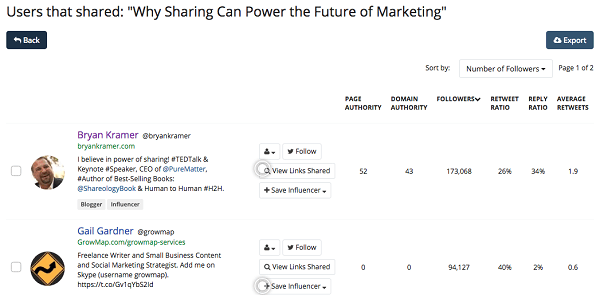
BuzzSumo will populate a list of content that’s been shared on social media with the option to View Sharers, which creates a new report of the Twitter accounts that shared a particular article or page on your website.
This report helps your company identify who’s already sharing your content, the number of Twitter followers they have, the average number of retweets these users get and what percentage of their tweets are replies and retweets as compared to regular tweets.
Review this report and identify Twitter users with an engaged audience that shares your content or content of a similar subject. These may be influencers worth contacting and building a relationship with or who simply deserve a “thank you” from your marketing team.
Finding the influencers already interested in your content and building a stronger relationship with them can help lead to more promotion of your content on social media, as well as more mentions online that result in additional backlinks to your website.
Attracting Influencers: If your company’s content isn’t currently being shared by influencers you’re excited about, then use BuzzSumo to identify what influencers are sharing as it relates to your industry overall.
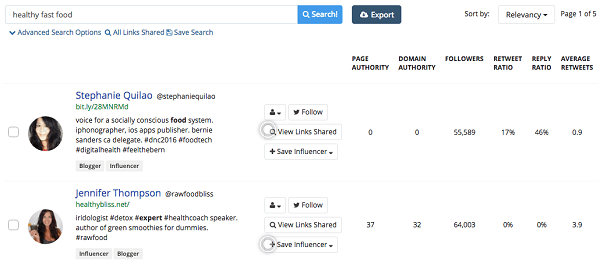
Using BuzzSumo, search for topics related to your company’s offerings and expertise to get listings of influential accounts on Twitter sharing content related to the particular topic. In the example above, we searched for the topic “healthy fast food” to find experts discussing the subject across Twitter.
This data can help inform outreach to tastemakers in your industry, which can help increase the likelihood they’ll be interested in partnering with you, as they are already sharing related content to your own.
Now You Have a Complete SEO Audit – Where Do You Go from Here?
That’s a wrap! In our opinion, these are the most important areas to pay attention to when conducting an SEO audit of your website.
If the previous information seems overwhelming, you might want to work with an SEO agency that can get these tasks completed quickly and effectively for you. Use the following tips to make your case.
How to Make the Case for Growing Your SEO Budget
There’s no questioning the benefits and importance of a sustainable SEO strategy for increasing your brand awareness, driving traffic and growing revenue streams. But when it comes time to make a case to invest more into your SEO budget, the conversations can start to get a bit tricky.
For an SEO specialist, the theory is basic: the more attention and budget that you allocate to SEO, the better your business will perform in the search engines, which relates to an increase in business opportunities and sales. Unfortunately, this isn’t always the case, and even an SEO strategy that is performing well and delivering results can be difficult to prove.
SEO strategies are constantly evolving, and these changes can be difficult to keep up with for those not directly involved in the industry. In addition, SEO is often misunderstood by decision makers. The tactics either sound overly technical, or the ROI models are unclear. These factors can create uncertainty and hesitation when it’s time to consider investing more money into your SEO campaigns.
In order to build a better case for growing your SEO budget, you should present evidence that SEO will help your company drive more traffic, improve its search position against competition, increase lead opportunities, grow revenue and ultimately produce a positive ROI.
What Decision Makers Need to Know About SEO
SEO is an investment in your business. As with many other investment opportunities, it can take a considerable amount of time before you start generating a noticeable return, sometimes up to 12 months. You should set this expectation from the start, because often decision makers are interested in immediate results. They’re likely to be considering other strategies that may produce a quicker ROI or appear more valuable at the time.
For example, a decision maker could be interested in budgeting for more employees, adding new tools for existing strategies, increasing advertising spending or a variety of other investments. Increasing their SEO spending could be the last thing on their mind if they haven’t yet seen evidence of a positive return or don’t realize the long-term commitment that an SEO strategy requires to be successful.
If your company is currently investing in an SEO strategy, you should produce concrete data that helps prove to the decision maker that investing in SEO has been an effective use of your company budget. The challenge for many marketers and SEO specialists is that this data can be difficult to find or can take months to accumulate, all the more reason to be transparent with the decision maker to help them better understand to be patient with results.
To combat this mindset, you should be collecting and documenting key metrics that help prove the effectiveness of your SEO investment. Present data that compares your keyword rankings and organic search traffic prior to your SEO investment with what you now receive. If there is a noticeable increase, this can be an indication that your SEO campaigns are gaining traction, and this may pique the interest of your decision makers.
Be wary, though. Organic search traffic can often be attributed to other marketing initiatives, and a decision maker may want to know the direct correlation between their SEO investment and an increase in traffic. To avoid simply using your intuition, you should cross-reference your organic traffic with the data from other marketing campaigns. This can help you build a better understanding of where your traffic came from and how effective your SEO campaigns are.
Search traffic and keyword growth can provide some initial data to get the ball rolling, but what really excites decision makers is how this is actually affecting the bottom line. If you’re ranking higher with keywords that a qualified lead is likely to search, you should be able to make the case that you’re not only driving more traffic and creating more conversion opportunities, but you are directly affecting sales.
Good SEO can improve conversion rates, a strong argument to grow your budget.
To back these claims, analyze your lead generation and conversion rates from before and after implementing your SEO strategy. The more in-depth data that you can provide, the stronger your argument for growing your budget is likely to be.
If you don’t have any actionable data that proves your SEO initiatives yet, you should create and document a clear plan to collect this information. Collaborate with the following departments to develop a stronger strategy and gather support for your SEO campaigns moving forward.
Leadership — Communicate with your leadership and decision makers to gain a better understanding of what their expectations and goals are when investing in SEO. With this information, you can find the metrics that are most important to report on and better focus on presenting that data.
Marketing and Sales — Collaborate with the marketing and sales teams to better understand what keywords are most important to them and how growing SEO can relate to an increase in sales. These teams are often directly affected by the performance of your SEO campaigns and are likely to have ideas on how growing your SEO budget would help benefit the business. Their suggestions can help fuel your case.
IT — Creating buy-in from the IT department may be one of the most important aspects to consider when growing your SEO budget, since they are most responsible for the technical implementation. The success of your campaigns can largely depend on how well they can perform. You should ensure that they have the skills and available resources to grow your SEO efforts effectively.
Outsourced SEO Service Providers — An SEO agency generally staffs a variety of experts, each likely to have a different opinion on why you should grow your budget. By asking them how you should best make a case for SEO, you can collect further information and resources that you need to present a better case to your decision makers.
By collaborating with your coworkers and connecting with outside professionals, you can better ensure that the interests and goals of your business are well-presented in your argument. Decision makers like to see that you have done your due diligence and have analyzed every aspect of your strategy prior to asking for more money.
Offer a Variety of Solutions and Budget Options
There is rarely a solution that is correct for every business in all situations, and SEO is no different. When deciding what budget might best suit your increased SEO needs, you should approach your decision makers with a good, better and best-case scenario. This allows for the team to ultimately decide which approach is best for the business and can help them juggle the wants and needs of other departments when finalizing a budget.
The following could be an example of a marketing director putting all of the research together and making a case for his or her mid-sized SaaS company to grow their SEO budget. Remember, the more research and data you can provide, the more powerful your argument is likely to be.
Good — “If we continue to spend at our current pace for SEO, we can expect similar growth over the next year. Data suggests that we are moving up the ranks for the following keywords, and we can attribute this primarily to our SEO budget. The sales manager mentioned that she needs to see more leads to reach our current sales goals and with our current spending option, we may come up short.”
Better — “By moderately increasing our SEO budget, we should have the opportunity to expand into other keywords and continue to build upon the success we’ve seen with our current keywords. We can expect our organic traffic to grow 5-10% after about 6 months. At our current lead generation rate, this could give our sales team a 1-3% boost in leads, which can greatly improve their chances for hitting our company goals. We spoke with the IT department, and they wouldn’t need additional resources to implement this change, but the sales team may need an additional employee.”
Best — “We think that we can really hit a home run and increase our bottom line if we invest heavily in content marketing to boost our SEO efforts. Our current data suggests that by doubling our budget, we may see a 40-50% boost in traffic, and our sales could skyrocket. With this plan we would need to hire three to five more employees, otherwise we would need to consider contracting with an outside firm to improve our SEO efforts. We’ve worked through a few different scenarios for accomplishing this, and we can safely expect to not only hit this year’s revenue goals but to continue reaching and exceeding them for the next 18 to 24 months.”
The situations and the numbers implied above are, of course, arbitrary, but you should take these concepts and apply them to your own business strategies and goals to find the best solutions for you and your team.
Making a case for growing your SEO budget can be a tricky challenge, but by educating your decision makers and providing a variety of budgeting options and value propositions that benefit your business, you can properly frame your argument as a win-win scenario for the entire company.
If you need more help, we’ve got your back. Hire the experts at Digital Current for SEO services you can count on.
*Full Disclosure: We only feature services and products we honestly believe in and our perspectives are genuinely our own expert perspective. This post may contain affiliate links from which we earn a small commission, at no additional cost to you.


